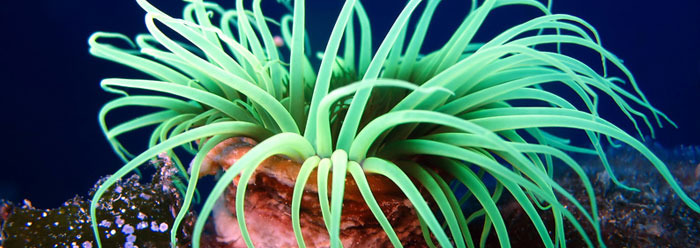@WFS,World Fossil Society,Riffin T Sajeev,Russel T Sajeev
Fossil Anemone Tracks Don’t Fit Evolution
Interesting markings were recently found on a rock in Newfoundland. A study concluded that they were trails left by seafloor-dwelling animals around 565 million years ago. But such a find is difficult to reconcile with the evolutionary teaching that muscles, and therefore animal locomotion, did not evolve until much later.
Before they could suggest that evolutionary history ought to be rewritten on this point, researchers first had to be quite certain that they were looking at some kind of animal track. They found over 70 tracks up to 13mm wide and 17cm long. At the end of some of the marks in siltstone was a circular kind of “footprint.” The traces cannot be scratch marks, because they show curves and “directional changes.”1 Does any living animal make similar markings on today’s seafloors?
In their study published in the Geological Society of America’s journal Geology, British and Canadian paleontologists determined that the tracks were comparable to those made by certain modern sea anemones. They wrote, “Anemones are capable of crawling across sediment and can exhibit swimming and burrowing behavior.”1 And anemones have a tubular body plan, which is consistent with the creature that made these tracks.
If correct, this extends muscular animal locomotion “five million years earlier”1 than previous evolutionary thinking had held. Fossil finds consistently cause a rewriting of evolutionary history. There are often as many versions of it as there are scientists looking into the relevant fossils.
For example, a recent find of tracks made by a four-legged creature in Poland demonstrated that animals with fully operable legs were walking long before their supposed ancestors, such as Tiktaalik, “emerged.”2 That highly debated fossil was initially hailed as one of the earliest creatures to make the evolutionary transition from water to land. Although the Polish tracks should erase Tiktaalik’s transitional status, the removal of its accompanying story from textbooks and museums promises to be painstakingly slow.
The Geology study’s authors concluded their report on the Newfoundland tracks with, “We consider that these impressions are consistent with locomotion traces produced by a cnidarian-like organism.”1 Cnidarians are animals that include jellyfish and sea anemones. But how cnidarian-like was it? Since it was presumably able to live, reproduce, consume, metabolize, and move around enough to leave behind a trail, there is no empirical reason to believe that it was anything less than a real and complete sea anemone, perhaps like those living today.
If so, sea anemones may take the prize for the most stable animal life form over the longest evolutionary period of time. Though a body fossil found nearby―either horizontally or below―would provide higher quality evidence that these tracks were indeed made by sea anemones, the evidence at present is convincing.
That would mean that not only do anemones appear suddenly and fully formed in the fossil record, but they were able to leave behind prints of their characteristic circular footpad and have retained the same form since. The anemone has therefore not evolved significantly in “565 million years,” a wildly unlikely assertion in the context of macroevolution.3
The evidence may not fit the evolutionary story, but it does not conflict with biblical history. Ediacaran deposits like the one the tracks were found in can be thought of as remains from the pre-Flood ocean floor. Though in many places it would have been ripped up, reworked, and re-deposited by the great Flood, it appears that some of it was covered over and preserved by flood-borne sediments. Most often, this material lies far beneath vast fossil-bearing flood deposits, but it crops up in a few places around the globe.
In any case, the animal that made these tracks definitely had the ability to move. And moving animals today must use a fully intact suite of precisely specified muscle proteins, including actin, myosin, and a host of supporting enzymes for construction and operation. In jellyfish, which are often transparent, there are no muscle cells. They do have, however, the same muscle proteins as muscle cells have, although the protein suite resides in their skin cells.
Interdependent, complicated systems like these never spontaneously “emerge.” They are always intentionally constructed. And sea anemones, if they are indeed responsible for these tracks, were apparently constructed correctly from the start of creation only thousands, not billions, of years ago.4
References
- Liu, A. G., D. McIlroy, D. and M. Brasier. 2010. First evidence for locomotion in the Ediacara biota from the 565 Ma Mistaken Point Formation, Newfoundland. Geology. 38 (2): 123-126.
- Sherwin, F. Banner Fossil for Evolution Is Demoted. ICR News. Posted on icr.org January 27, 2010, accessed February 18, 2010.
- The same problem is evident with the damselfly and other living fossils. See Thomas, B. New Population Found of Damselfly ‘Living Fossil.’ ICR News. Posted on icr.org January 19, 2010, accessed February 19, 2010.
- DeYoung, D. 2005. Thousands, Not Billions. Green Forest, AR: Master Books.
@WFS,World Fossil Society,Riffin T Sajeev,Russel T Sajeev



 June 18th, 2018
June 18th, 2018  Riffin
Riffin 
 Posted in
Posted in  Tags:
Tags: 